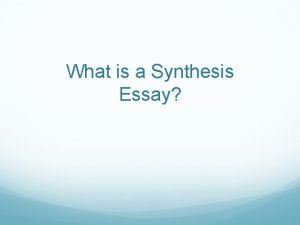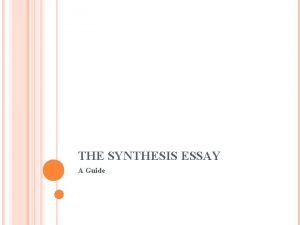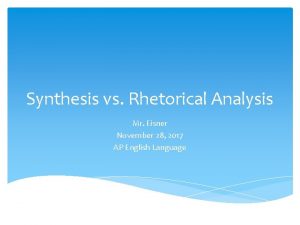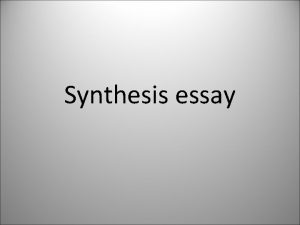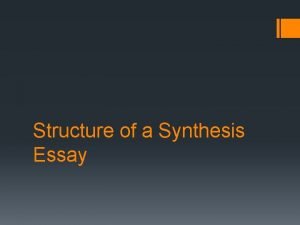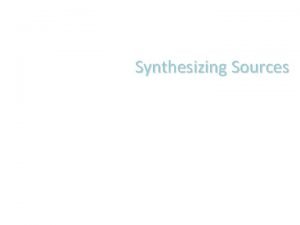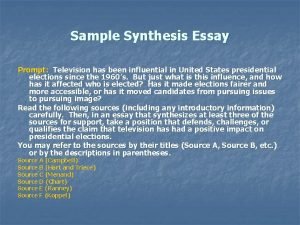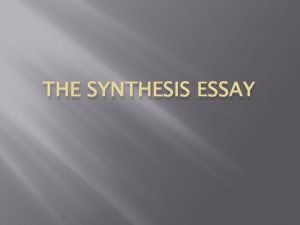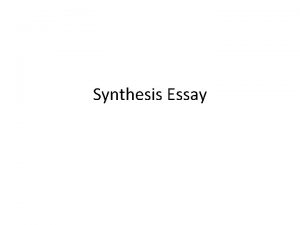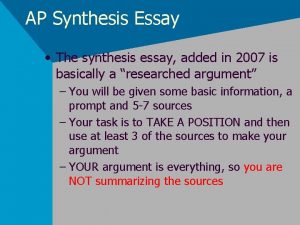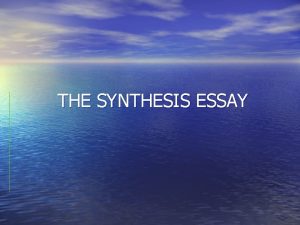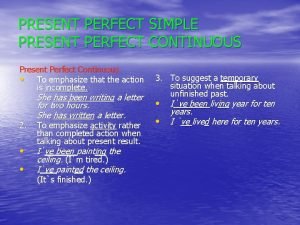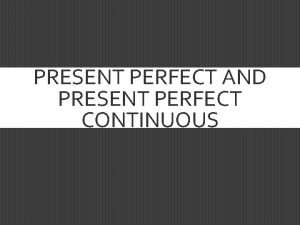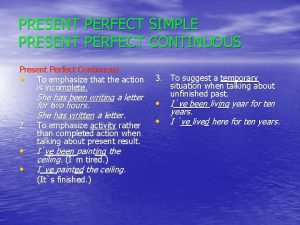Synthesis Essay How to write a perfect synthesis


























- Slides: 26

Synthesis Essay How to write a perfect synthesis essay

Purpose? � The college Board wants to determine how well the student can do the following: � Read critically � Understand texts � Analyze text � Develop a position on a given topic � Support a position with appropriate evidence � Incorporate outside sources into the texts of the essay � Cite sources used in the essay

What’s it like? � The prompt contains an Introduction and description of an issue that has varying viewpoints associated with it.

What’s it like? � Along with the topic, you will be given a selection of sources: � Text � Non-fiction � Poetry � Chart � Letter � News article � Photo � Fiction � cartoon

What’s it like? � After carefully reading and annotating the sources, you must respond to the prompt and integrate and correctly cite at least three of the sources in your response.

What kinds of synthesis essays can I expect? The first possibility is an EXPOSITORY Develop thesis and support with specific examples from sources by any of these strategies: • • • Compare and contrast Cause and effect Analysis

What kind of essay can I expect? � The second kind of synthesis essay presents an ARGUMENT. � For an argumentative essay, you will take a position based on the prompt, and support, refute, or qualify and support with the sources.

Timing and Planning the Synthesis Essay: First 15 Minutes � Deconstruct the synthesis prompt � Read annotate each of the given texts related to the synthesis prompts � Decide how you will address the prompt

After the first 15 minutes � 5 -6 minutes going back to the texts and deciding which you will use in your essay � 8 -10 minutes planning the support of your position � 20 minutes writing the essay � 3 -4 minutes checking to make certain that you have incorporated at least three sources into your response � 3 minutes proofreading

Working the Prompt � You must spend time carefully reading and deconstructing the prompt! � Carefully read introductory material and the assignment. � THE INTRODUCTORY MATERIAL IS CENTRAL TO COMPLETING THE PROMPT AS DIRECTED. DO NOT SKIP IT!

Develop your opening paragraph Do this: I have decided to use Source A _ Source B _ Source C _ Souce D_ Set up your thesis paragraph • Direct reference to the prompt and/or introduction • Clearly state your point (main idea) • Write your thesis

Write the body of your essay � Use a variety of ways to integrate your source material: � Begin with an attribution (According to ___) � Paraphrase and cite (source C). � Clips from direct quotes and cite Contrary to what the court sees as “permissible public use” (source C), a government foreclosing on a home goes against personal property rights.

Add a conclusion � Do not rehash or summarize! � Add a pertinent memorable point or come full circle from your opening.

Structuring an Argument � An argument has two sides, and to effectively argue, it’s essential to present points of view within the context of your paper.

Structure of an Argument � Classical � Rogerian � Toulmin

Classical Argument Began in ancient Greece around 5 th century B. C. � Communicated orally and designed to be easily understood by listeners � Based on formal logic, including the syllogism � Six main components

Classic Argument Structure 1) Introduction: captures attention of audience; urges audience to consider your case 2) Statement of Background: narrates the key facts and/or events leading up to your case 3) Proposition: states the position you are taking, based on the information you’ve already presented, and sets up the structure of the rest of your argument 4) Proof: discusses your reasons for your position and provides evidence to support each reason 5) Refutation: anticipates opposing viewpoints; then demonstrates why your approach is the only acceptable one (i. e. better than your opponents’) 6) Conclusion: summarizes your most important points and can include appeals to feelings or values (pathos)

Toulmin Model � Developed by British philosopher Stephen Toulmin in the 1950’s � Emphasizes that logic often based on probability rather than certainty � Focuses � Three on claims primary components

Toulmin Model Claim = My parents should allow me to go to my friend’s party on Friday night. Data = The parents of nearly all of the juniors at UHS have given their children permission to attend this party. Warrant = My parents should act in accordance with the other parents of juniors at UHS.

Uh oh. . A potential snag. . . What if my parents don’t “buy” my warrant? What if they don’t think they should necessarily do what other parents are doing? How can I still get permission to attend the party? Or at least have a better chance of getting permission?

Try a new warrant and new data What might be more convincing data for an audience of parents? What might be a warrant that most parents will share?

Rogerian Strategy � Developed by psychologist Carl Rogers (also in the ’ 50 s) � Emphasizes problem-solving and/or coming to consensus � Allows the author to appear openminded or even objective � Appropriate in contexts where you need to convince a resistant opponent to at least respect your views

Rogerian Strategy � � Introduction: statement of problem to be solved or question to be answered � � Summary of Opposing Views: described using a seemingly objective persona � Statement of Understanding: concedes circumstances under which opposing views might be valid � Statement of Your Position � � Statement of Contexts: describes contexts in which your position applies/works well � � Statement of Benefits: appeals to self-interest of readers who may not yet agree with you; demonstrates how your position benefits them

Set up your argument with the Rogerian model in mind Set up of thesis paragraph � Introductory Statement � Statement of the problem to be solved � Summary of understanding of each side � Thesis : Begin with Although or While First = Concession Second = Position you are supporting

Sample Rogerian Thesis Statements � Possible Thesis � Although laws restricting cell phone use while driving are an infringement on personal privacy and a violation of First Amendment rights, legislation must be passed that bans the use of all communication devices while driving to protect others from distracted drivers. � Although the use of communication devices while driving is proven to be distracting and potentially dangerous, laws banning usage infringe on personal privacy, and an individual’s First Amendment rights must be protected at all costs.

Assignment � 1. Review the notes on the synthesis essay. � 2. Read and outline the introductory material and prompt. � 3. Decide what position you will take and list your reasons and any examples that come to mind. � 4. Decide how you will respond to the prompt. � 5. Read annotate each source. Decide how you will use it in your essay (don’t forget concession) 6. Make a chart of those you plan to use. � A___ B ___ C ___ D ___ E ___ F ___ �
 How do you analyse something
How do you analyse something Perfect present
Perfect present What is a synthesis essay
What is a synthesis essay Synthesis essay samples
Synthesis essay samples Synthesis essay definition
Synthesis essay definition Synthesis essay outline
Synthesis essay outline Rhetorical vs synthesis essay
Rhetorical vs synthesis essay Synthesis apush
Synthesis apush Whats a synthesis essay
Whats a synthesis essay Sharenting synthesis essay
Sharenting synthesis essay Is college worth it synthesis essay
Is college worth it synthesis essay Ap lang synthesis essay prompt 2007
Ap lang synthesis essay prompt 2007 What is synthesis
What is synthesis What is a synthesis essay
What is a synthesis essay Ap lang synthesis essay television presidential elections
Ap lang synthesis essay television presidential elections Present perfect tense examples in hindi
Present perfect tense examples in hindi Present perfect pay
Present perfect pay Present perfect simple and continuous difference
Present perfect simple and continuous difference Change to present perfect tense
Change to present perfect tense Past simple vs present continuous
Past simple vs present continuous Past simple tense past continuous
Past simple tense past continuous Past continuous past simple past perfect
Past continuous past simple past perfect Always past perfect
Always past perfect تفاوت future perfect و future continuous
تفاوت future perfect و future continuous Past tense past continuous past perfect
Past tense past continuous past perfect Infinitive present perfect
Infinitive present perfect Present perfect indicative
Present perfect indicative


